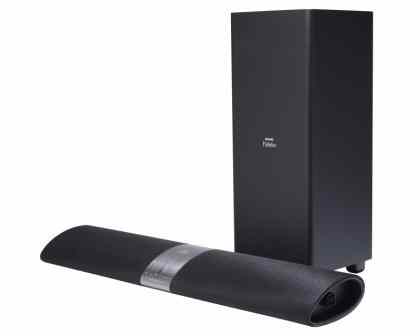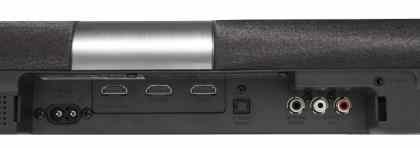Sound bars are still relatively new to many people in comparison to surround sound speaker systems, but we’re already expecting more from them than simply better audio quality for watching TV and films. Philips was clearly on the same wavelength when it produced the Fidelio HTL9100. It’s a sleek sound bar that splits apart into surround sound speakers when you want that authentic cinema experience.

In its default configuration, the HTFL9100 looks like any other sound bar. It shares the same sleek and minimal design as the entry-level HTL5120, with black cloth speaker grilles and plenty of brushed aluminium. The teardrop-shaped unit will sit comfortably in front of your TV without obscuring its IR port, but looks equally stylish mounted to a wall. There’s no LCD display, but the row of white LEDs illuminate to show you volume, bass or treble levels as you adjust them with the simple remote control.
We’re used to sound bars skimping on inputs and outputs, but Philips has been generous when it comes to connectivity. The HTL9100 has two HDMI inputs and a single HDMI output that supports Audio Return Channel (ARC) to let you use the external speakers with your TV’s integrated Freeview or Freesat tuner. You’ll also find analogue RCA, digital coaxial and digital optical audio inputs at the back, along with an easier to reach 3.5mm input on one side.

As the HTL9100 has built-in Bluetooth, you won’t even need to break out a cable to stream music from a smartphone or tablet. The HTL9100 doesn’t have an onscreen interface, so you must rely on the remote control to trigger the process and watch the LEDs to know when you’re connected.
In its standard soundbar mode with the satellite speakers attached to the main soundbar, the HTL9100 sounds warm and detailed whether you’re playing music or watching TV. The high-end is precise without sounding sharp, which makes acoustic tracks sparkle, but there’s enough low-end grunt to give presence to heavier tracks too. There’s admittedly not a lot of stereo separation, but that’s to be expected from a single sound source.

It’s when the unit’s broken down to produce two rear speakers that the HTL9100 shows its true potential. They lock firmly into the main unit with magnets, but once removed they instantly switch over to wireless mode, using a proprietary frequency to avoid conflicting with Bluetooth or Wi-Fi signals. Each speaker has an internal battery charges whenever you return it to the main unit. Philips says each one will last 10 hours, so it’ll take a Lord of the Rings marathon to drain them in a single sitting.
